Abstract
1 (+)-Lysergic acid diethylamide (LSD) mimicked 5-hydroxytryptamine (5-HT) in its ability to stimulate fluid secretion, to change transepithelial and intracellular potentials as well as to increase the cyclic 3′,5′-adenosine monophosphate (cyclic AMP) concentrations of isolated salivary glands of Calliphora.
2 Unlike 5-HT, LSD disengages slowly from the receptor and fluid secretion continues despite repeated washing.
3 Both 5-HT and tryptamine prevented LSD from acting on the glands.
4 LSD bound to the receptor was slowly displaced when glands were treated with agonists (tryptamine) or antagonists (gramine).
5 The property of LSD which permits it to function as an agonist despite remaining tightly bound to the receptor is discussed as a possible basis for its profound effects within the central nervous system.
Full text
PDF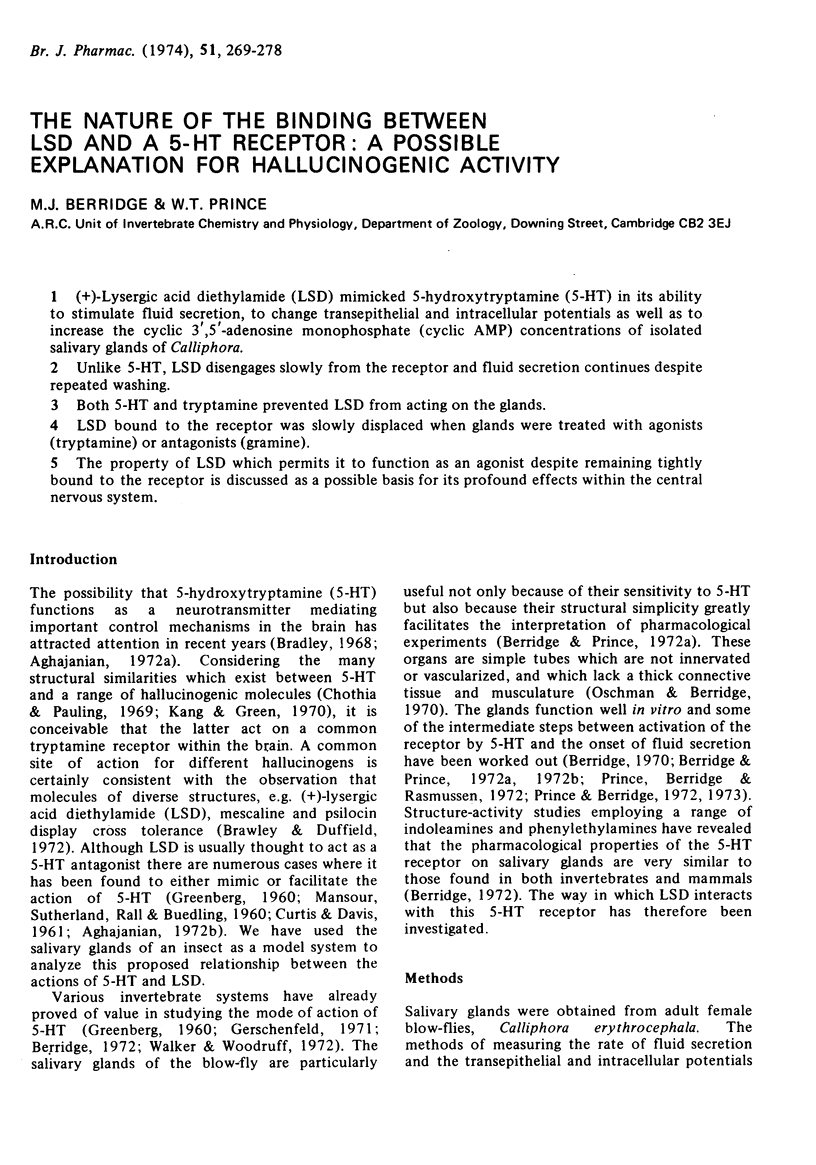
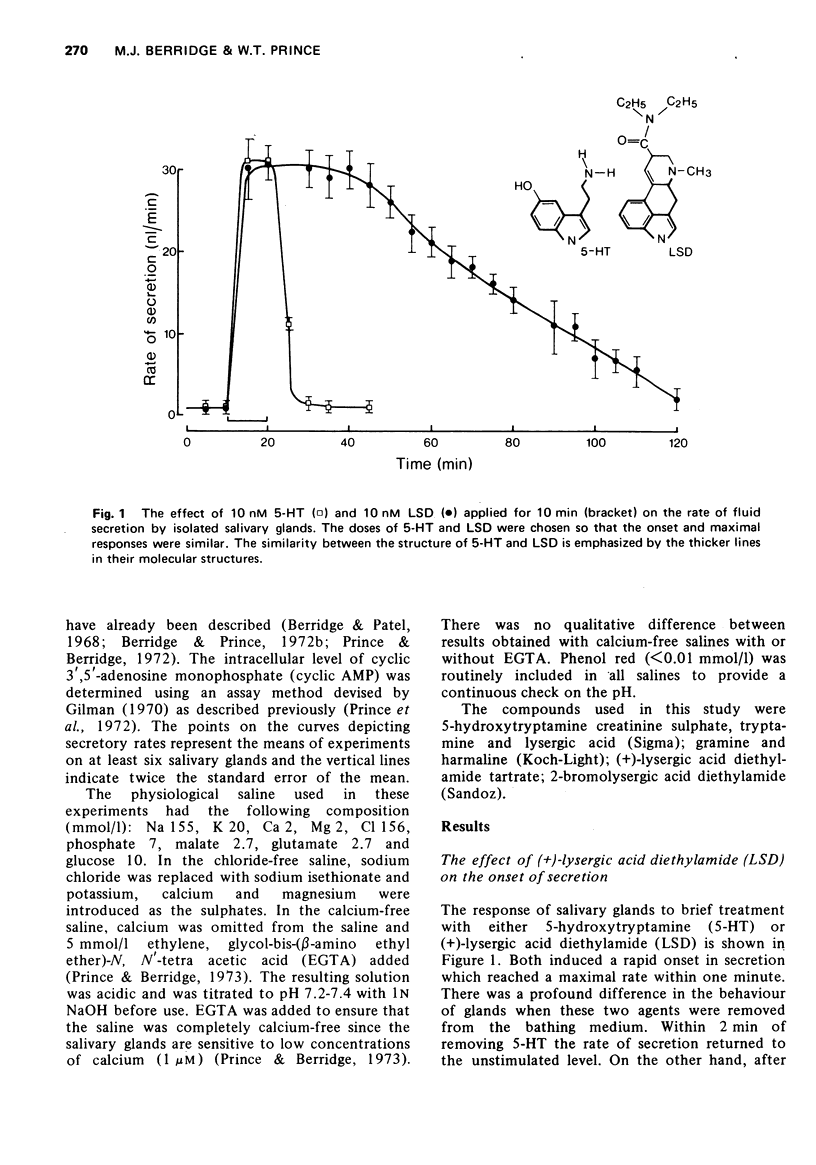
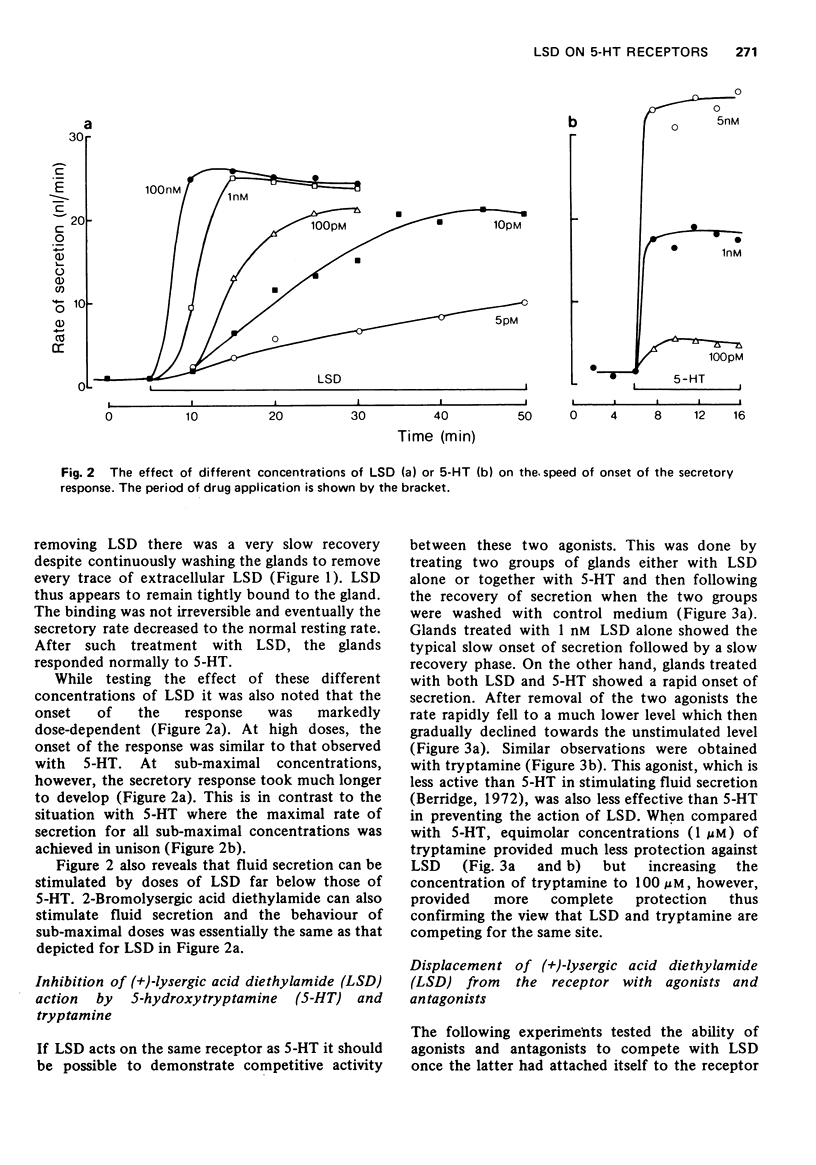
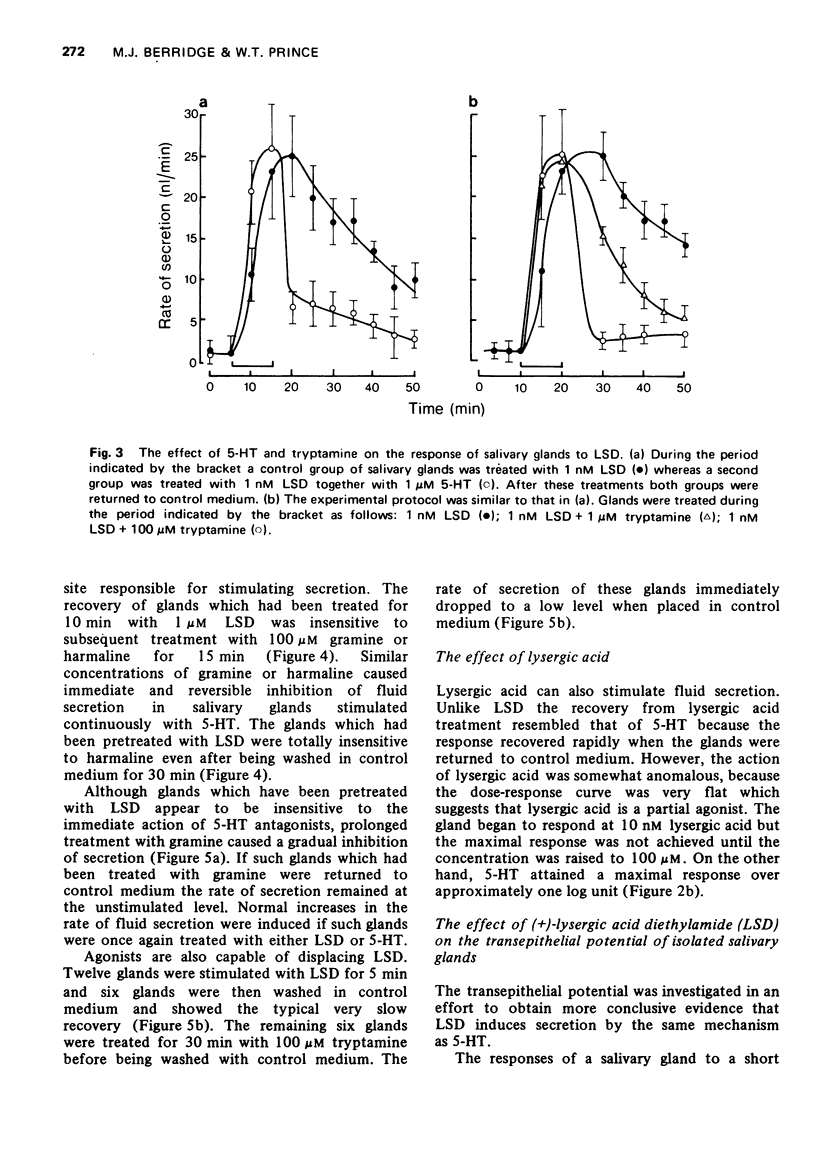

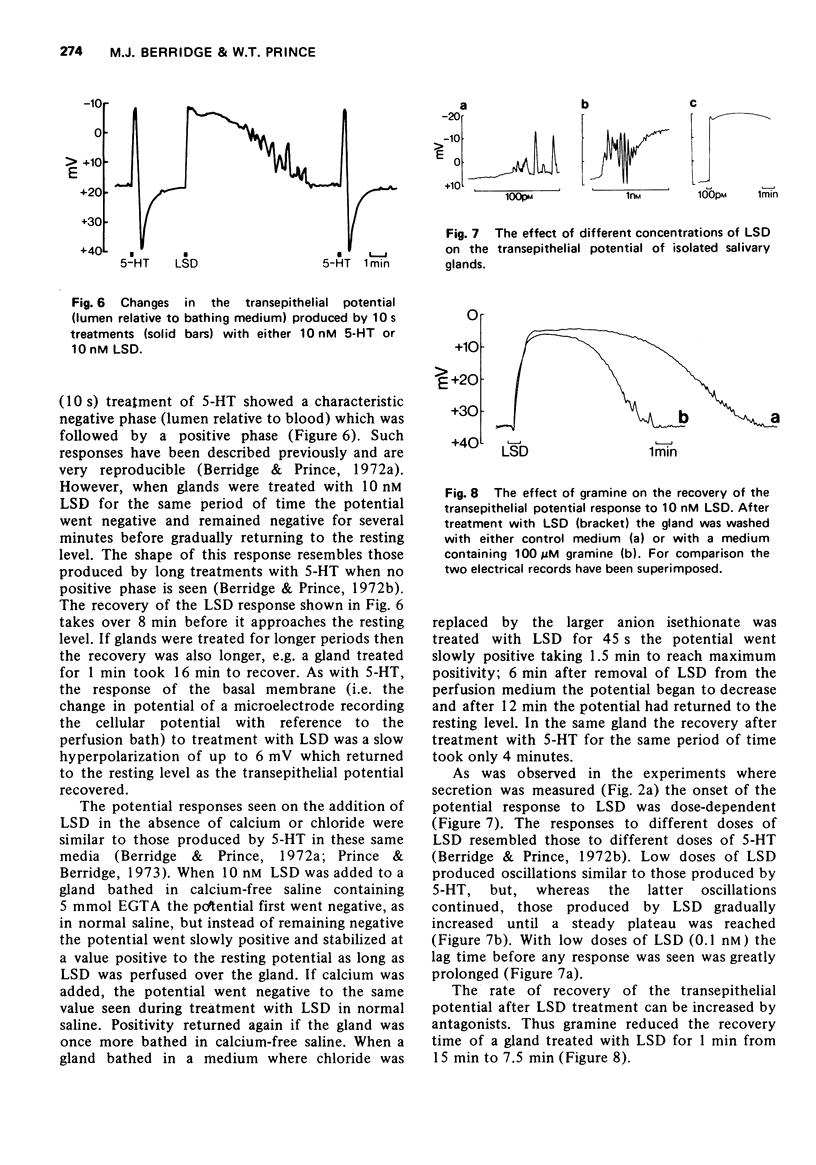
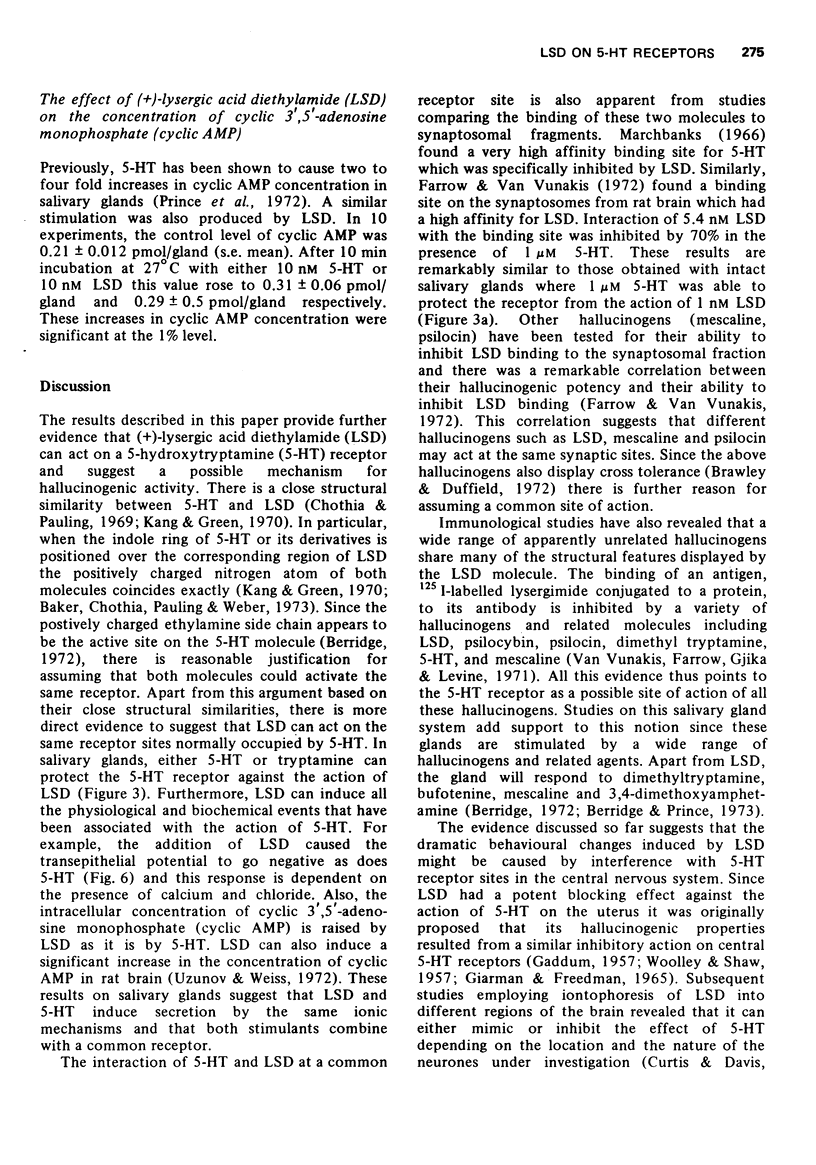



Selected References
These references are in PubMed. This may not be the complete list of references from this article.
- Aghajanian G. K. Influence of drugs on the firing of serotonin-containing neurons in brain. Fed Proc. 1972 Jan-Feb;31(1):91–96. [PubMed] [Google Scholar]
- Baker R. W., Chothia C., Pauling P., Weber H. P. Molecular structures of hallucinogenic substances: lysergic acid diethylamide, psilocybin, and 2,4,5-trimethoxyamphetamine. Mol Pharmacol. 1973 Jan;9(1):23–32. [PubMed] [Google Scholar]
- Berridge M. J., Patel N. G. Insect salivary glands: stimulation of fluid secretion by 5-hydroxytryptamine and adenosine-3',5'-monophosphate. Science. 1968 Oct 25;162(3852):462–463. doi: 10.1126/science.162.3852.462. [DOI] [PubMed] [Google Scholar]
- Berridge M. J., Prince W. T. Mode of action of hallucinogenic molecules. Nat New Biol. 1973 Jun 27;243(130):283–284. doi: 10.1038/newbio243283a0. [DOI] [PubMed] [Google Scholar]
- Berridge M. J., Prince W. T. Transepithelial potential changes during stimulation of isolated salivary glands with 5-hydroxytryptamine and cyclic AMP. J Exp Biol. 1972 Feb;56(1):139–153. doi: 10.1242/jeb.56.1.139. [DOI] [PubMed] [Google Scholar]
- Berridge M. J. The mode of action of 5-hydroxytryptamine. J Exp Biol. 1972 Apr;56(2):311–321. doi: 10.1242/jeb.56.2.311. [DOI] [PubMed] [Google Scholar]
- Berridge M. J. The role of 5-hydroxytryptamine and cyclic AMP in the control of fluid secretion by isolated salivary glands. J Exp Biol. 1970 Aug;53(1):171–186. doi: 10.1242/jeb.53.1.171. [DOI] [PubMed] [Google Scholar]
- Boakes R. J., Bradley P. B., Briggs I., Dray A. Antagonism of 5-hydroxytryptamine by LSD 25 in the central nervous system: a possible neuronal basis for the actions of LSD 25. Br J Pharmacol. 1970 Oct;40(2):202–218. doi: 10.1111/j.1476-5381.1970.tb09914.x. [DOI] [PMC free article] [PubMed] [Google Scholar]
- Bradley P. B. Synaptic transmission in the central nervous system and its relevance for drug action. Int Rev Neurobiol. 1968;11:1–56. doi: 10.1016/s0074-7742(08)60383-9. [DOI] [PubMed] [Google Scholar]
- Brawley P., Duffield J. C. The pharmacology of hallucinogens. Pharmacol Rev. 1972 Mar;24(1):31–66. [PubMed] [Google Scholar]
- CURTIS D. R., DAVIS R. A central action of 5-hydroxytryptamine and noradrenaline. Nature. 1961 Dec 16;192:1083–1084. doi: 10.1038/1921083a0. [DOI] [PubMed] [Google Scholar]
- Chothia C., Pauling P. On the conformations of hallucinogenic molecules and their correlation. Proc Natl Acad Sci U S A. 1969 Aug;63(4):1063–1070. doi: 10.1073/pnas.63.4.1063. [DOI] [PMC free article] [PubMed] [Google Scholar]
- Farrow J. T., Van Vunakis H. Binding of d-lysergic acid diethylamide to subcellular fractions from rat brain. Nature. 1972 May 19;237(5351):164–166. doi: 10.1038/237164a0. [DOI] [PubMed] [Google Scholar]
- GADDUM J. H. Serotonin-LSD interactions. Ann N Y Acad Sci. 1957 Mar 14;66(3):643-7; discussion, 647-8. doi: 10.1111/j.1749-6632.1957.tb40754.x. [DOI] [PubMed] [Google Scholar]
- GIARMAN N. J., FREEDMAN D. X. BIOCHEMICAL ASPECTS OF THE ACTIONS OF PSYCHOTOMIMETIC DRUGS. Pharmacol Rev. 1965 Mar;17:1–25. [PubMed] [Google Scholar]
- GREENBERG M. J. Structure-activity relationship of tryptamine analogues on the heart of Venus mercenaria. Br J Pharmacol Chemother. 1960 Sep;15:375–388. doi: 10.1111/j.1476-5381.1960.tb01260.x. [DOI] [PMC free article] [PubMed] [Google Scholar]
- Gilman A. G. A protein binding assay for adenosine 3':5'-cyclic monophosphate. Proc Natl Acad Sci U S A. 1970 Sep;67(1):305–312. doi: 10.1073/pnas.67.1.305. [DOI] [PMC free article] [PubMed] [Google Scholar]
- Kang S., Green J. P. Steric and electronic relationships among some hallucinogenic compounds. Proc Natl Acad Sci U S A. 1970 Sep;67(1):62–67. doi: 10.1073/pnas.67.1.62. [DOI] [PMC free article] [PubMed] [Google Scholar]
- MANSOUR T. E., SUTHERLAND E. W., RALL T. W., BUEDING E. The effect of serotonin (5-hydroxytryptamine) on the formation of adenosine 3',5'-phosphate by tissue particles from the liver fluke, Fasciola hepatica. J Biol Chem. 1960 Feb;235:466–470. [PubMed] [Google Scholar]
- MCCOY A. C., WELSH J. H. Actions of dlysergic acid diethylamide and its 2-bromo derivative on heart of Venus mercenaria. Science. 1957 Feb 22;125(3243):348–348. doi: 10.1126/science.125.3243.348. [DOI] [PubMed] [Google Scholar]
- Marchbanks R. M. Serotonin binding to nerve ending particles and other preparations from rat brain. J Neurochem. 1966 Dec;13(12):1481–1493. doi: 10.1111/j.1471-4159.1966.tb04309.x. [DOI] [PubMed] [Google Scholar]
- Prince W. T., Berridge M. J., Rasmussen H. Role of calcium and adenosine-3':5'-cyclic monophosphate in controlling fly salivary gland secretion. Proc Natl Acad Sci U S A. 1972 Mar;69(3):553–557. doi: 10.1073/pnas.69.3.553. [DOI] [PMC free article] [PubMed] [Google Scholar]
- Prince W. T., Berridge M. J. The effects of 5-hydroxytryptamine and cyclic AMP on the potential profile across isolated salivary glands. J Exp Biol. 1972 Apr;56(2):323–333. doi: 10.1242/jeb.56.2.323. [DOI] [PubMed] [Google Scholar]
- Tebécis A. K., Di Maria A. A re-evaluation of the mode of action of 5-hydroxytryptamine on lateral geniculate neurones: comparison with catecholamines and LSD. Exp Brain Res. 1972 Apr 27;14(5):480–493. doi: 10.1007/BF00236590. [DOI] [PubMed] [Google Scholar]
- Van Vunakis H., Farrow J. T., Gjika H. B., Levine L. Specificity of the antibody receptor site to D-lysergamide: model of a physiological receptor for lysergic acid diethylamide. Proc Natl Acad Sci U S A. 1971 Jul;68(7):1483–1487. doi: 10.1073/pnas.68.7.1483. [DOI] [PMC free article] [PubMed] [Google Scholar]
- WOOLLEY D. W., SHAW E. N. Evidence for the participation of serotonin in mental processes. Ann N Y Acad Sci. 1957 Mar 14;66(3):649-65; discussion, 665-7. doi: 10.1111/j.1749-6632.1957.tb40755.x. [DOI] [PubMed] [Google Scholar]


